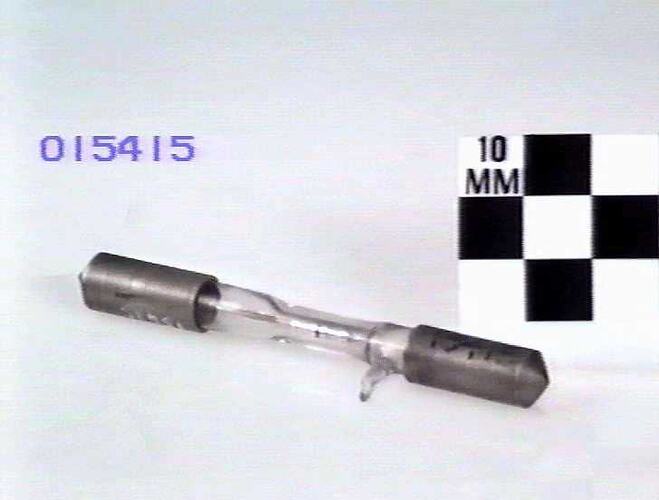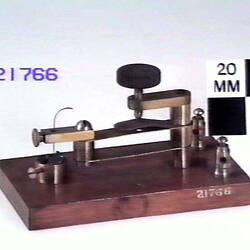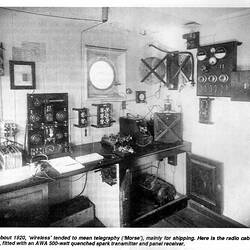Summary
Coherer: Telefunken type, made by Gesellschaft Fur Drahltose Telegraphie in Germany, circa 1905. Used by donor Mr A.F. Newman, of Amalgamated Wireless (Australasia) Ltd, about 1905-1906. This was not the first commercial form of coherer.
The coherer was a primitive form of radio signal detector used in the first generation of radio receivers during the early wireless telegraphy era, that lasted from the mid-1890s until around WWI. Its use in early radio recievers was based on a discovery by French physicist Edouard Branly in 1890, who observed that small metal particles or filings could be made to move or jump in the presence of an electric current passing through a wire or an electric spark. The discovery was adapted by Branly and other physicists and inventors over the next ten years to form the first commercial radio receivers. By 1893, British scientists had suggested that Branly's metal filings tube could be used to detect 'Hertzian waves', later known simply 'radio waves'. It was the British physicist Oliver Lodge, who first named this type of detector a 'coherer', during a memorial lecture that he delivered on 1st June 1894, following the death of the German physicist Heinrich Hertz. In May 1895, after reading about Lodge's demonstrations, the Russian physicist Alexander Popov built a 'Hertzian wave' (radio wave) based lightning detector using a coherer. That same year Italian inventor Guglielmo Marconi demonstrated a wireless telegraphy system using radio transmission and detection of Morse Code signals based on a coherer.
The coherer consists of a tube or capsule containing two electrodes spaced a small distance apart with loose metal filings in the space between. When a radio frequency signal is applied to the device, the metal particles cling together or 'cohere', reducing the initial high resistance of the device, thereby allowing a much greater direct current to flow through it. In a radio receiver, the current would activate a bell, or a Morse paper tape recorder to make a record of the received signal. The metal filings in the coherer remained conductive after the signal (pulse) ended so that the coherer had to be 'decohered' by tapping it with a clapper, such as a doorbell ringer, each time a signal was received, thereby restoring the coherer to its original state. Coherers remained in widespread use until replaced by the crystal detector, developed around 1906, and later vacuum tube (radio valve) technologies such as John Ambrose Fleming's thermionic diode and Lee De Forest's Audion (triode) tube, developed from 1912.
Physical Description
Consists of evacuated clear glass tube with internal electrodes, possibly aluminium and silver, with gold filings between. End caps of metal. Glass tube has a pinch off leg extending from one side. This object is physically attached by two fine twisted wires to a display board on which a Crystal Detector (ST 21766) is also mounted.
More Information
-
Collecting Areas
-
Acquisition Information
Donation from Amalgamated Wireless (Australasia) Ltd, 05 Sep 1924
-
Manufacturer
-
Inscriptions
None on coherer. Display board labelling: 'EARLY SEMICONDUCTOR DEVICES / THE COHERER - 1905 [refers to ST 15415] / THE CRYSTAL DETECTOR - 1920 [refers to ST 21766] / A crystal of CARBURUNDUM (Silicon Carbide) in point / contact with a wire called a CAT'S WHISKER rectified / incoming RADIO FREQUENCY SIGNALS.'
-
Classification
-
Category
-
Discipline
-
Type of item
-
Overall Dimensions
80 mm (Length), 15 mm (Width), 8 mm (Outside Diameter)
Width include small glass leg on side of tube.
-
References
Wiki: Telefunken: [Link 1] viewed 21 Sep 2012. Phillips, Vivian J. (1980). Early Radio Wave Detectors. London: Inst. of Electrical Engineers. ISBN 0906048249. 'A comprehensive description of radio detectors up to the development of the vacuum tube, with many unusual types of coherer.' Coherer (12 Jan 2017), In Wikipedia, The Free Encyclopedia, [Link 2] viewed 5 June 2017.
-
Keywords


